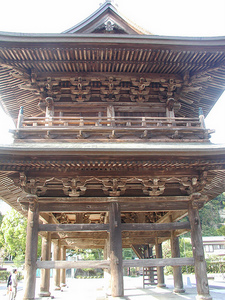Difference between revisions of "Kencho-ji"
(done for now :)) |
|||
| Line 1: | Line 1: | ||
| + | [[Image:Kenchoji-sanmon.jpg|right|thumb|300px|The main gate, or "Tanuki-mon," at Kenchô-ji.]] | ||
*''Founded: [[1253]], [[Doryu|Dôryû]]'' | *''Founded: [[1253]], [[Doryu|Dôryû]]'' | ||
*''Japanese'': 建長寺 ''(kenchou-ji)'' | *''Japanese'': 建長寺 ''(kenchou-ji)'' | ||
| Line 6: | Line 7: | ||
It was founded in [[1253]], when [[Hojo Tokiyori|Hôjô Tokiyori]] invited the Chinese ([[Song Dynasty|Song]]) monk [[Doryu|Dôryû]] to found it. Dôryû would be the first to be named a Japanese Zen master by a Japanese Emperor. | It was founded in [[1253]], when [[Hojo Tokiyori|Hôjô Tokiyori]] invited the Chinese ([[Song Dynasty|Song]]) monk [[Doryu|Dôryû]] to found it. Dôryû would be the first to be named a Japanese Zen master by a Japanese Emperor. | ||
| − | Though originally quite large, with 49 ''[[tatchu|tatchû]]'' (sub-compounds), after many fires and such in the [[Sengoku period]], Kenchô-ji was rebuilt in the [[Edo period]] in its current form. A dragon painting on the ceiling of the ''[[hatto|hattô]]'' (lecture hall) was created by ''[[Nihonga]]'' painter Koizumi Junsaku in 2000, in honor of the then-upcoming 750th anniversary of the temple's founding. | + | Though originally quite large, with 49 ''[[tatchu|tatchû]]'' (sub-compounds), after many fires and such in the [[Sengoku period]], Kenchô-ji was rebuilt in the [[Edo period]] in its current form, as just a single temple complex. A Shintô shrine located in the hills directly above the temple serves as the ''[[chinju]]'' guardian shrine for the temple; chiefly associated with ''[[Hansobo|Hansôbô gongen]]'', a deified ''[[tengu]]'', the shrine contains includes numerous statues of ''tengu'', scattered across a small section of the hill. |
| + | |||
| + | A dragon painting on the ceiling of the ''[[hatto|hattô]]'' (lecture hall) was created by ''[[Nihonga]]'' painter Koizumi Junsaku in 2000, in honor of the then-upcoming 750th anniversary of the temple's founding. | ||
The temple's bell, cast in [[1255]], has been designated a [[National Treasures|National Treasure]], while the main gate to the temple, built in [[1754]], is known as the Tanuki-mon ("badger gate") on account of a legend involving a [[tanuki]] who transformed himself into a monk and worked to raise money for the gate, in order to repay the monks' kindness to him. | The temple's bell, cast in [[1255]], has been designated a [[National Treasures|National Treasure]], while the main gate to the temple, built in [[1754]], is known as the Tanuki-mon ("badger gate") on account of a legend involving a [[tanuki]] who transformed himself into a monk and worked to raise money for the gate, in order to repay the monks' kindness to him. | ||
| − | |||
| − | |||
==References== | ==References== | ||
*Plaques on-site. | *Plaques on-site. | ||
| + | *"[http://www.kamakura-burabura.com/meisyokitakamakurakentyouji.htm Kenchô-ji]." Kamakura-Burabura.com 鎌倉ぶらぶら. | ||
| + | |||
| + | ==External Links== | ||
| + | *[http://maps.google.com/maps/place?cid=770162204733939314&q=%E5%BB%BA%E9%95%B7%E5%AF%BA&hl=en&ved=0CFAQ-gswAA&sa=X&ei=3QElT6CkF5eEzAWTwKipDA&sig2=wMf40xWFAVmkYFuJCol4ew Kenchô-ji on Google Maps] | ||
[[Category:Temples]] | [[Category:Temples]] | ||
[[Category:Kamakura Period]] | [[Category:Kamakura Period]] | ||
Revision as of 04:25, 29 January 2012
Kenchô-ji is the top temple of the Kamakura Gosan (Kamakura Five [top Zen] Temples), and the head temple of the Kenchô-ji branch of Rinzai Zen.
It was founded in 1253, when Hôjô Tokiyori invited the Chinese (Song) monk Dôryû to found it. Dôryû would be the first to be named a Japanese Zen master by a Japanese Emperor.
Though originally quite large, with 49 tatchû (sub-compounds), after many fires and such in the Sengoku period, Kenchô-ji was rebuilt in the Edo period in its current form, as just a single temple complex. A Shintô shrine located in the hills directly above the temple serves as the chinju guardian shrine for the temple; chiefly associated with Hansôbô gongen, a deified tengu, the shrine contains includes numerous statues of tengu, scattered across a small section of the hill.
A dragon painting on the ceiling of the hattô (lecture hall) was created by Nihonga painter Koizumi Junsaku in 2000, in honor of the then-upcoming 750th anniversary of the temple's founding.
The temple's bell, cast in 1255, has been designated a National Treasure, while the main gate to the temple, built in 1754, is known as the Tanuki-mon ("badger gate") on account of a legend involving a tanuki who transformed himself into a monk and worked to raise money for the gate, in order to repay the monks' kindness to him.
References
- Plaques on-site.
- "Kenchô-ji." Kamakura-Burabura.com 鎌倉ぶらぶら.
